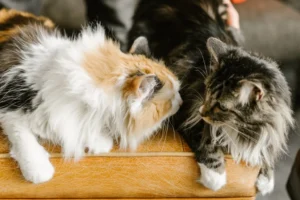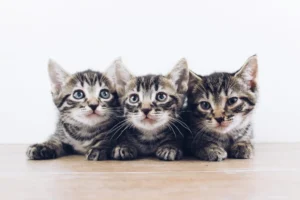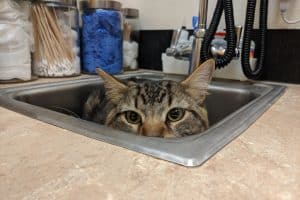Male cats forcing female cats to mate can be a puzzling behavior for many pet owners. Understanding the reasons behind this behavior is crucial to providing the best care for your feline companions.
When male cats force female cats to mate, it is often driven by instinctual behaviors and the need to ensure the survival of their genes. The urge to mate is strong in male cats, and they may resort to forceful tactics to ensure successful reproduction.
Natural Instincts and Mating Behaviors
Male cats forcing female cats to mate can be attributed to their natural instincts and mating behaviors. In the wild, male cats are driven by a strong urge to reproduce and pass on their genes to the next generation. This instinct is deeply ingrained in their DNA, pushing them to seek out females to mate with.
When a male cat forces a female cat to mate, it is often a result of biological programming that compels them to engage in mating behaviors. This can involve behaviors such as chasing, mounting, and vocalizing, all of which are instinctual actions aimed at mating.
Furthermore, male cats may exhibit territorial behaviors that lead them to assert dominance and control over females in their environment. This territorial instinct can manifest in aggressive behaviors towards female cats, leading to forceful mating attempts.
Understanding these natural instincts and mating behaviors can shed light on why male cats feel the need to force females to mate. It is essential to recognize and respect these instincts while also ensuring the safety and well-being of all cats involved.
Territorial and Dominance Factors
Territorial and dominance factors play a crucial role in male cats’ behavior of forcing female cats to mate. In the feline world, territory is key, and male cats may exhibit aggressive mating behaviors as a way to assert their dominance and control over a particular area.
Male cats may view female cats as possession within their territory, leading them to compel mating through forceful means. This behavior is driven by a combination of territorial instincts and the desire to establish dominance over both the female and the surrounding environment.
Additionally, competition among male cats for mating opportunities can also fuel territorial and dominance behaviors. Male cats may engage in forceful mating attempts as a way to outcompete other males and ensure their genes are passed on successfully.
By understanding the role of territorial and dominance factors in male cats’ behavior, we can take steps to manage and mitigate these behaviors to create a safe and harmonious environment for all cats in a multi-cat household or community setting.
Extra Insight : Providing enrichment such as vertical space, hiding spots, and interactive toys can help alleviate territorial stress in male cats, reducing the likelihood of forceful mating behaviors.
Remember, by addressing these underlying factors and catering to the natural instincts of male cats, we can create a peaceful and balanced environment for all felines involved.
Impact on Female Cats
Male cats forcing female cats to mate can have detrimental effects on the physical and emotional well-being of female cats. Physically, forced mating can lead to injuries such as scratches, bites, and even internal damage due to rough handling. This can cause pain, discomfort, and potential health complications for the female cat. Emotionally, the stress and trauma of being forced to mate can result in anxiety, fear, and even depression in female cats. It can also lead to a breakdown in the natural mating behavior of female cats, affecting their overall well-being and quality of life.
Prevention and Intervention
To prevent male cats from forcing female cats to mate, it is crucial to provide a safe and controlled environment for your pets. Spaying and neutering your cats can help reduce the drive to mate and prevent unwanted litters. Additionally, it is important to supervise interactions between male and female cats, especially during mating season when hormones are high. Intervene immediately if you witness any aggressive behavior or forced mating attempts. Providing separate spaces for male and female cats can also help minimize the chances of forced mating. Remember, creating a safe and comfortable environment for your cats is essential in preventing such behavior.
Additional Unique Insight: A useful strategy to prevent male cats from forcing female cats to mate is to provide plenty of mental and physical stimulation for your pets. Engaging them in interactive play, providing scratching posts, and offering plenty of toys can help redirect their energy and reduce the likelihood of aggressive mating behavior. Keeping your cats mentally and physically stimulated can help improve their overall well-being and prevent unwanted mating attempts.
The Role of Neutering
Neutering is crucial in reducing instances of male cats forcing female cats to mate. Neutering male cats helps decrease their aggressive mating behavior and prevents them from feeling the need to assert dominance through force. By spaying female cats, you can also prevent unwanted pregnancies and reduce the chances of females being overwhelmed or injured by persistent males. Neutering your cats not only helps manage population control but also promotes a calmer and safer environment for your pets.
Additional Unique Insight:
Consider neutering your cats at a young age to maximize the benefits of this procedure. Early neutering can help prevent ingrained mating behaviors from developing, leading to a more peaceful relationship between male and female cats.
Understanding Cat Behavior
Understanding cat behavior is key to addressing the issue of male cats forcing female cats to mate. Cats have complex communication methods that often involve subtle cues and body language. Male cats may exhibit aggressive mating behaviors when they misinterpret signals or when they are not properly socialized. It’s essential to observe and interpret your cats’ interactions to identify any signs of stress or discomfort. By creating a harmonious environment and addressing any behavioral issues early on, you can help prevent forced matings and ensure a healthy dynamic between your cats.
Remember, cat behavior is not always straightforward; if you’re unsure about your pets’ interactions, don’t hesitate to seek advice from a veterinarian or animal behaviorist for professional guidance.
By taking proactive steps such as neutering your cats and educating yourself on feline behavior, you can foster a safe and mutually respectful relationship between male and female cats in your household.
Providing a Safe Environment
Creating a safe environment for your cats is crucial in preventing instances of forced mating. Cats may feel stressed or threatened in certain situations, which can lead to aggressive behavior from male cats towards female cats. Ensure your cats have access to separate spaces where they can retreat if they feel overwhelmed. Additionally, provide plenty of hiding spots, high perches, and scratching posts to help reduce tension and promote a sense of security.
Establishing a predictable routine can also help alleviate stress for your cats. Regular feeding times, play sessions, and quiet periods for relaxation can all contribute to a harmonious environment. By reducing stress and anxiety, you can lower the chances of your male cat feeling the need to force mating on a female cat.
Lastly, consider providing ample resources such as food, water, litter boxes, and toys to prevent competition between your cats. Having multiple resources available can help reduce conflict and create a more peaceful living space for your feline companions.
Additional Tip: Providing vertical space, such as cat trees or shelves, can give your cats more options for exploration and relaxation, reducing the likelihood of confrontations that may lead to forced mating.
By prioritizing a safe and stress-free environment for your cats, you can help prevent instances of forced mating and promote a harmonious relationship between male and female cats.
Alex, a passionate animal lover, has experience in training and understanding animal behavior. As a proud pet parent to two dogs and three cats, he founded AnimalReport.net to share insights from animal experts and expand his knowledge of the animal kingdom.









